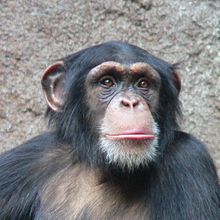Physics with Calculus/Introduction/For Biologists
Living organisms are part of the physical world. The science of Biology depends upon physics and chemistry in many ways. When a chimpanzee uses its eyes, photons interact with molecules in the retina to trigger chemical reactions inside cells. The light-induced chemical changes lead to the movement of ions across cell membranes and the propagation of electrical signals along axons leading into the brain from the eyes. For vision, most animals are mainly dependent upon light that comes to the Earth from the nearest star. The photopigments in our eyes have been selected through the process of evolution to efficiently interact with just those colors of light that predominate in sunlight.

A fruit tree can capture the energy of photons and convert that energy into chemical energy that is stored in sugar molecules. When a chimpanzee eats, food molecules become available as sources of energy inside cells for purposes like pumping ions across cell membranes. These pumped ions make possible the electrical signals of neurons that allow a chimpanzee to be consciously aware of what it sees. Most life on Earth depends on the conversion of matter to energy by fusion reactions inside the sun.

Atoms such as iron that are required for the normal function of our cells were produced by nuclear reactions inside stars many billions of years ago. Many powerful tools for biology research depend on technologies that rely on the work of physicists. Scanning laser microscopes allow us to probe the structure of cells by making use of the physical fact that certain particles such as photons can be packed densely into the same physical space. Brain scanning techniques rely upon nuclear disintegrations or the magnetic properties of atoms. There is no real boundary between physics and biology; some scientists work in hybrid fields such as biophysics. It is often convenient to specialize in either biology or physics, but ultimately the results biology and physics must be consistent.
As a biology major, you are aware of the idea that human understandings of life have changed dramatically during recorded history and continue to change. It is only relatively recently that biological evolution could be understood in terms of mutations in DNA molecules. In the history of the study of life there was a dramatic conceptual reorientation from the idea that biological species were fixed forms to the current view of living organisms as dynamically evolving forms. Similarly, physics has undergone such conceptual revolutions. We now know that conservation of energy and conservation of mass do not hold when there is conversion between energy and mass. However, in biology there are many situations where it is still useful to make use of ideas like conservation of energy and conservation of mass. In Part I, we start our exploration of physics with these fundamental physical concepts.